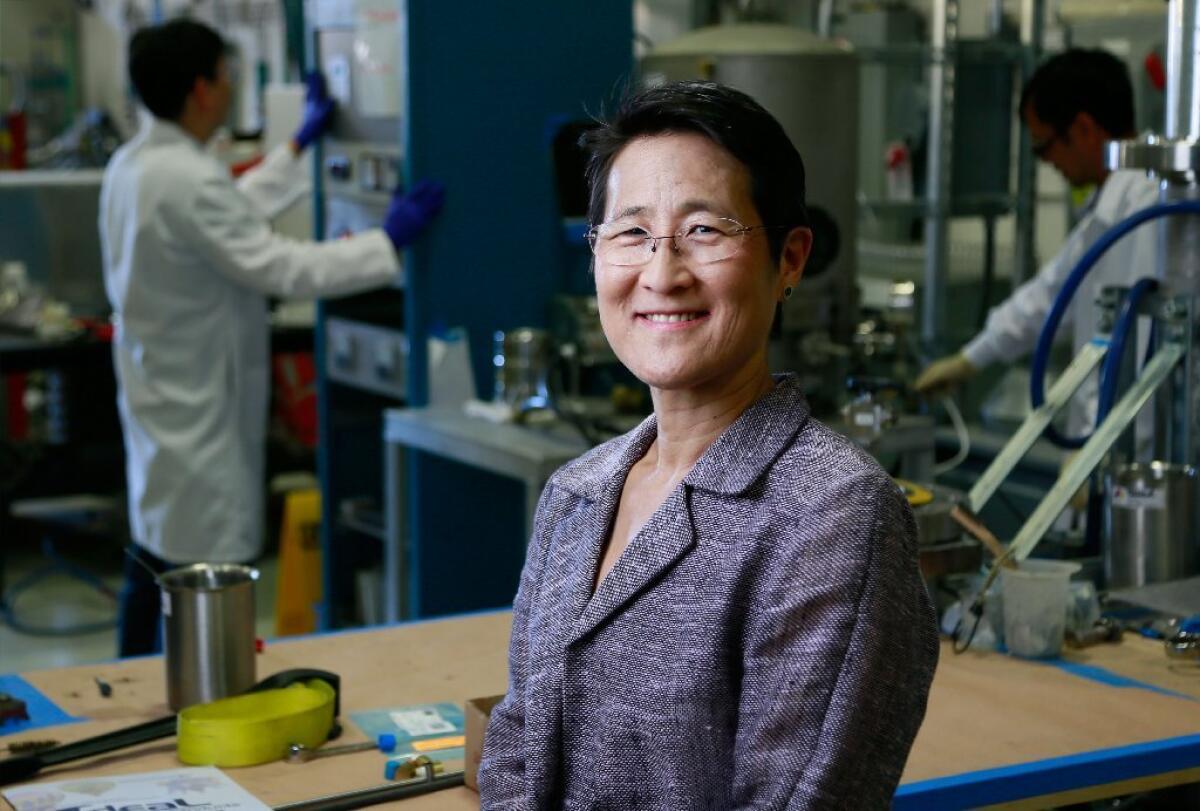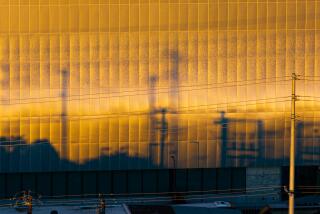General Atomics’ $40-million gamble on small nukes

- Share via
The scientists and engineers at General Atomics think the future of nuclear energy is coming on the back of a flatbed truck.
The leadership at the San Diego company, which has been developing nuclear technologies for more than 60 years, has already spent $40 million in the expectation that its ambitious plans for the next generation of reactors will actually work.
“We have technology that we think is going to qualitatively change the game,” said Christina Back, vice president of nuclear technologies and materials at General Atomics.
Called the Energy Multiplier Module, or EM² (EM-squared), the concept is still in the development stage but promises to produce electricity more cheaply, safely and efficiently than the nation’s current fleet of nuclear plants.
It’s a material that’s like the ceramic in your coffee mug. It doesn’t melt.
— Christina Back, General Atomics
It’s designed to produce a reactor so compact that the company’s handout material shows it being transported by tractor-trailer.
But EM² is still a long way from becoming reality.
Just building a prototype, Back said, is at least 10 years away, and “we’re looking at 2030-ish” before a commercial reactor could be operational using EM² technology.
EM² is among the most promising of the 30 to 40 independent designs underway in the U.S., said Ted Quinn, a former president of the American Nuclear Society.
“It has strong merit and deserves attention,” Quinn said.
EM² aims to tackle a number of chronic issues that have long plagued the industry.
Nuclear power plants are big and expensive. The cost for two new units at the Vogtle plant in Georgia, the first to be built in the U.S. in 30 years, has grown to $16 billion.
Back estimated the cost of a plant using EM² technology at $4.6 billion.
Plus, the new design requires half the construction time — an estimated 42 months — of current reactors.
EM² is part of a growing class of nuclear projects called SMRs -- small modular reactors -- that are a fraction of the size of conventional plants such as the San Onofre nuclear plant.
Like modular homes, SMRs are built in sections in a factory, with the advantage of being more quickly assembled.
Despite its size, each reactor at a proposed EM² plant would produce electricity at higher power density, a measure of the energy flow, and at much higher temperatures, boosting thermal efficiency from the 33% seen in current reactors to 53%.
The design uses tubes made of silicon carbide, or “cladding,” which hold uranium and can withstand the heat coming from the core of the EM² reactor.
“It’s a material that’s like the ceramic in your coffee mug,” Back said. “It doesn’t melt and that means you can go up to much higher temperatures without failing.”
General Atomics calls for each plant to be made up of four modules, each generating 265 megawatts of electricity in a steady mode.
Together, the four modules would generate a little more than a gigawatt of electricity, about the same output as a typical nuclear plant. One gigawatt can power about 800,000 homes.
Unlike so-called light-water reactors in use, the EM² design uses helium to cool its core, and the inert gas flows through the plant’s turbines to make electricity. That eliminates the need to locate a plant near a large water supply, giving EM² the advantage of operating virtually anywhere.
The silicon carbide wouldn’t interact with water and make hydrogen, something that led to an explosion at the Fukushima nuclear site in Japan in 2011.
Because the fuel doesn’t melt, the plant doesn’t require a source of electricity to keep the plant safe.
“We’re using new technologies that allow us to make the core much more compact and we would put it underground for added safety,” Back said.
The EM² design burns existing nuclear reactor waste as fuel, helping alleviate some of the storage issues plaguing existing plants.
“Since we can reuse the spent fuel from a current reactor or from EM², we can keep burning it and burning it and get to 97% less waste,” Back said.
As a result of EM²’s greater efficiency, it uses only one-fifth of the fuel and one-fifth of the radioactive waste to produce the same amount of electricity as an existing reactor.
What’s more, the core can run for 30 years without needing to refuel or reposition fuel rods. Current light-water reactors need to be refueled every 18 months.
“We’re taking advantage of real changes in science,” Back said.
Natural gas may pose a challenge.
Techniques such as hydraulic fracturing and horizontal drilling have unlocked vast amounts of natural gas in North America, and the additional supply has lowered prices. Utilities are increasingly turning to natural gas power plants to generate electricity, at least in large part, because gas burns much cleaner than coal.
The industry points to the Obama administration’s Clean Power Plan — which calls for a 32% reduction in carbon emissions from hundreds of the nation’s power plants by 2030 — as evidence that the carbon-free features of nuclear power are needed now more than ever.
But nuclear has long faced intense opposition from those who consider it an inherently dangerous source of power, and the EM² technology is being developed at a time when nuclear plants are getting shut down in places such as Illinois, Vermont and New York.
The environment for nuclear power in California is even more daunting.
Last month, Pacific Gas & Electric Co., in conjunction with the Natural Resources Defense Council and other environmental groups, came up with a plan to close California’s last operating nuclear plant, Diablo Canyon. The facility near San Luis Obispo accounts for about 9% of California’s power generation.
NRDC senior scientist Matthew McKinzie said that even though he considered the EM² design “laudable” in its goals to reduce nuclear waste and improve safety, “our perspective is that energy efficiency technologies and renewable technologies have proven to be a faster, more cost-efficient, scaleable, reliable solution to address climate change.”
Back disagrees.
“I’m all for a diversity of [energy] sources — solar and wind, we should use them,” Back said. “I just don’t see how they can possibly take up the fraction of nuclear that is going to be disappearing.”
McKinzie said the success of any advanced nuclear technology largely rests on its performance in the prototype stage, which does not come cheaply. “When you’re talking on the order of a billion dollars to get to that point, that’s a pretty high hurdle,” said McKinzie, who holds a doctorate in experimental nuclear physics from the University of Pennsylvania.
In addition to the $40 million General Atomics has spent so far, the EM² concept has received government support. General Atomics was one of five companies that received a share of a $13-million award from the U.S. Department of Energy in October 2014.
“We’re not just a lab working on something because it looks interesting,” Back said. “We’re trying to solve an issue here.”
ALSO
No food or drinks on long-haul international flights? No problem
Desert Trip to nearly double the economic impact in Coachella Valley
Olympus told U.S. executives no broad scope warning was needed despite superbug outbreaks
More to Read
Inside the business of entertainment
The Wide Shot brings you news, analysis and insights on everything from streaming wars to production — and what it all means for the future.
You may occasionally receive promotional content from the Los Angeles Times.










